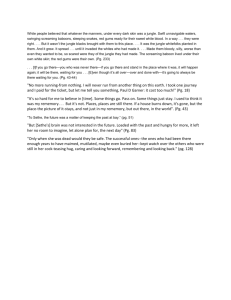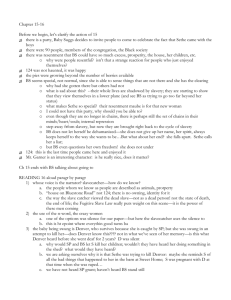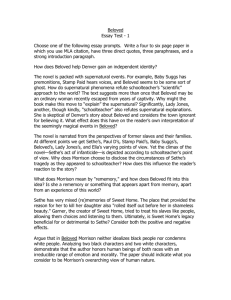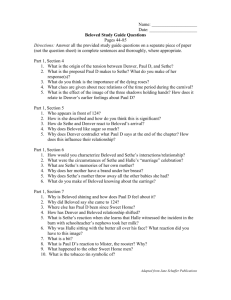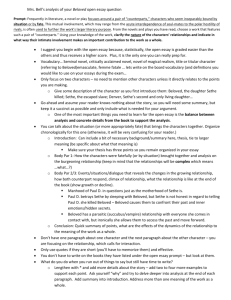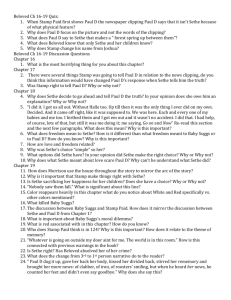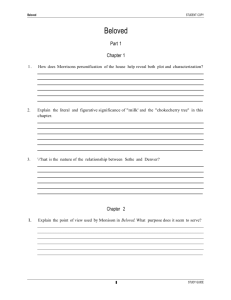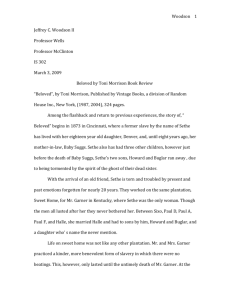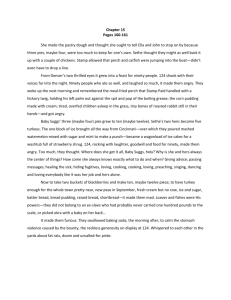a metaphor - Southwest High School
advertisement
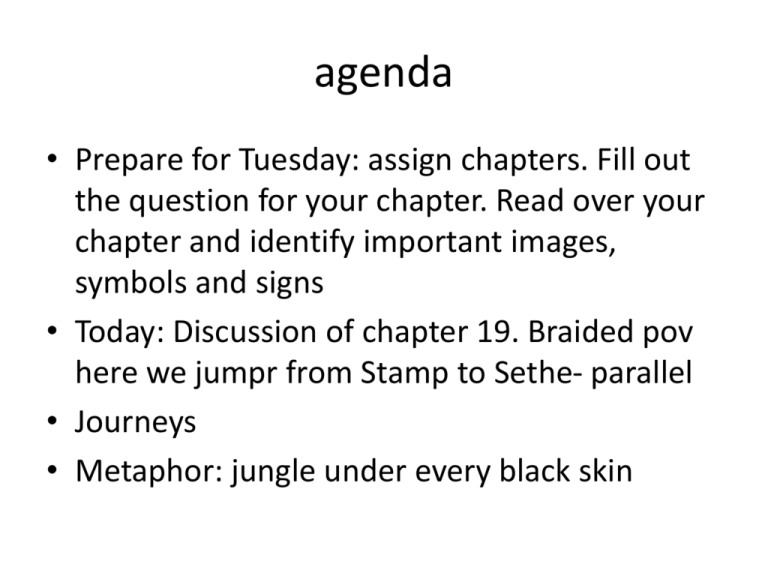
agenda • Prepare for Tuesday: assign chapters. Fill out the question for your chapter. Read over your chapter and identify important images, symbols and signs • Today: Discussion of chapter 19. Braided pov here we jumpr from Stamp to Sethe- parallel • Journeys • Metaphor: jungle under every black skin Chapter 19: Stamp Paid • • • • • • • p. 200 Why does he feel bad? “Pride Goeth before the Fall?” 202 Where does he go and why? 203 What’s with the voices around the house? red ribbon (213) Origin of his name? (Wife) 218 234 White people believed that whatever the manners, under every dark skin was a jungle. Sethe • Shift Pov: Sethe (203-208) – – – – What is the symbolism of the Ice skating? Nobody saw them falling What is the click? 207 P. 222 (her view of Paul D?) • On page 226: Who is Sethe talking to and why? What story is retold here? • Internal monologue; to Beloved, defending her actions What do we learn about the night of their escape 233? Baby Suggs (208-211) • What happened to her after “the Misery?” – She was going to bed to think about the color of things – They came in her yard… – “One or the other might have saved her, but beaten up by the claims of both, she went to bed” – (212 Jungle Metaphor • Slavery dehumanizes and degrades everyone: • The jungle the whites have planted has taken root and has spread to themselves as well. Agenda • Turn in paragraph on jungle metaphor • Get in groups- decide how you will present your section (chunks-every sentence, every two sentences? Choral voice on repeated words? • Group 7…I have a script for you to follow- see me. • Thesis and bullet points of main ideas due Fri. In-class paragraph 10 pts • Stamp Paid's meditation about the jungle in blacks and whites. • • What is the “jungle” referred to by Stamp Paid? Tie this in with the references to blacks as animals (School-teacher's observations, reactions to Sethe's act of murder, etc.), the white people's inhumanity, and Suggs's sermons. • • • • • 2 pts. Topic sentence 1 pt: speaker/thinker 4 pts literary devices 3 pts. commentary Quick writes 10 pts • • • • 2 pts. Topic sentence 1 pt: speaker/thinker 4 pts use of literary devices 3 pts. commentary Stream of consciousness • Associated with The Modernist movement • stream of consciousness is a form of interior monologue • Meant to represent the process of thought. • Free association of images and emotions Hearing the voices • 1. Present as interior monologue • 2 Tell us what new information these memories and thoughts have given us. Middle Passage • sections of the novel, where Beloved relatess the trauma of her death with the horrors of the slave ships. This is generally interpreted as Beloved "rememorying" aspects of her racial heritage. Sethe – 1. P. 236 Beginning of chapter to p.237 “Think what spring will bring…” – 2. P. 238 “First beating I took--p.239 “I can tell it to you.” Denver – 3 p. 242 Beg. To 243 Nelson Lord made me – 4 p. 246 bottom of page” Grandma Baby…to end Beloved – 5. 248 1st para. – 6 .251 “ I am standing in the rain-252 I want to join. • Group 7 Chorus (3 people) Chapter 23 – Whole thing Stream of consciousness • P251 • What are the important images in this? • What themes do they relate to? – Memory of earrings that her mother used to play with her – Desire not to be separate from Sethe, but part of her (“her face is mine.” – Iron collar-collective slave imagery-ships – 60 million slaves died on the journey from Africa to America – Hot thing – Men with no skin How are these four chapters linked? • motif of "mine," which reflects their strong love, their desperate need, and a dangerous desire to possess the other person. • Blended stream of consciousness • The three stream-of-consciousness monologues (Sethe's, Denver's, and Beloved’s) are followed by a lyrical chapter in which all three voices intermingle. In a famous phrase, Morrison calls them "unspeakable thoughts, unspoken”. • Three voices blended together into one • Identity has merged • Ownership: She is mine, She is Mine, She is mine. Chapter 24 • Paul D’s memories of what happened • Sequence of events • P. 258: He can no longer separate his strategy for closing off his heart and surviving. • Family P. 264-how has tense shifted and why? • • • • Present tense to make the memory more vivid Sequence of events…. Glance through last couple pages Round Robin Paul D 267 • After being captured he hears his price – $900.00 – Fears about his Manhood continue. He is not sure if he was ever really a man, or only acted like one because Garner taught him how. After 25 years, he is still uncertain of his masculinity and worth as a human being. ch. 25:Stamp Paid • 275 • End of part 2 • Why? Why? Why? Why? Why? Part 3 • In Part Three the relationship among the three women at 124 deteriorates as Beloved begins to devour everything, including (in a figurative sense) her mother. • Why does the community now come to Sethe's assistance after shunning her for 18 years? Ch 26: Themes Motherhood Effects of the past on the present Community memory What quotes do you have? • Read them to the class • Why are they significant? Motherhood and Past • 284-285 How is the imagery of Sethe wasting away symbolic? Motherhood On Page 286 Denver saw “themselves beribboned, decked-out, limp and starving but locked in a love that wore everybody out.” How does this love relate to the final stream of consciousness chapter? How do the references “your face is my face”, “ a hot thing” and references to “chewing and swallowing” relate to theme of motherhood and past effects of slavery? Community • What does this novel say about isolation versus community? • Why do the women come to Sethe’s defense and why? • Earlier in the book, Ella tells Stamp Paid that Sethe was her friend until she “showed her self.” Why the change in heart at the end? Why is she the one to lead the women to 124? • p 302: Ella didn’t like past errors taking posssession of the present. Why Other women? • Lady Jones • Janey Wagon agenda • Collect thesis statements: make sure you have a copy for yourself to work on this weekend • Crash course John Green video • Epilogue: Is it a story to pass on or not? • Quick write/share • How does ending resolve the issues presented in the beginning? Topic Sentence • In this quote from Stamp Paid, he is saying that white people view blacks as barely tamed, wild animals. • Revision: The “jungle” referred to by Stamp Paid symbolizes the dehuminization slavery causes. • More Revision: The “jungle” referred to by Stamp Paid symbolizes the dehuminization caused by slavery. remember • A topic sentence needs to be evaluative. It will be stronger and give the paragraph more direction if you relate it to a literary device. example • The jungle is a metaphor used by Morrison to illustrate the fear of the unknown between the whites and the Africans caused by the unnatural presence of slavery. Stamp paid explains the jungle as an abyss-like existence within each dark skinned person. This metaphor, along with various images of dangerous snakes, baboons, and rivers, reveals the fear of the unknown the whites had for the African slaves. The life like qualities Morrison bestows on the jungle invades the slave owners. The spread of the jungle is a reflection of the underlying theme of the inhumanity of slaverychanging and altering the human nature of both slaves and the slave owners in the process. Last chapter write: What does she mean? • 1. Why does the novel end the way it does? “It was not a story to pass on”? • The last chapter presents a contradiction. Although Beloved's story, according to the narrator, is not a story to pass on, the novel performs exactly that action. • Shift in tense: It was not a story to pass on • This is not a story to pass on. Writing activity • 1 Why does she end it with this ambiguous This is not a story to pass on? Discussion • 2 How does the ending relate back to the beginning of the novel? What issues have been resolved? Final thoughts For the characters of the novel, forgetting Beloved is a necessity. The past must be dealt with in a healthy way. Although traces of Beloved remind them of her from time to time, the dead remain dead, and the relationship between the characters and their past is allowed to become more manageable. For us, however, the story has to be passed on if we are to understand the history that is embodied in Beloved. • Beloved is referred to as the forgotten, the unnamed. The past • 295-296: Denver thought she understood the connection… – . Why does Denver leave? Community of Women • Lady Jones • Ella 300-01 • Janey Wagon Memory of the rape/killing • Never directly mentioned by Sethe. Morrison suggests rape took place, but Sethe refers to it as “they took my milk.” • What does the milk represent? – motherhood • They took the one thing that Sethe considered the best part of her.(until Paul D. tells her otherwise at the end. • The whites dirted her, dirtied all the slaves
